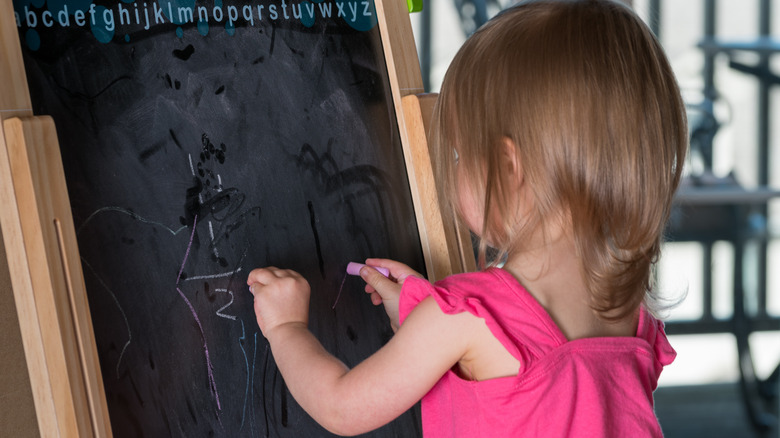How Rare Is It To Be Left-Handed?
How exactly do we as humans come to develop our dominant hand? Deciding which hand we raise in class, which one to write with, and in which direction we swing a bat feels almost automatic — something out of our control. In what stages of development do we establish ourselves as right-handed or left-handed?
Hand dominance pertains to one's "preference for using one hand over the other to perform fine and gross motor tasks," according to Verywell Family. Interestingly, this phenomenon does not appear to be exclusive to humans. Developments in research indicate that animals, from primates to walruses, to even octopuses, all have their own preferred appendage as well. With the vast majority of people around the world being right-handed, it appears that some species follow suit, with walruses seemingly preferring the use of their right flipper over their left.
While the reasons behind humans' affinity for right-handedness remain somewhat convoluted, there are those who prefer the use of their left hand, alternating hands, or using both equally. That being said, what exactly are the odds of becoming left-handed?
Factors that influence hand dominance
Hand dominance is primarily influenced by one's brain, as well as genetics, and is often established in childhood. In terms of a child's development stages, a 7-9 month-old infant will generally begin to implement the use of one hand, although a preference does not usually emerge until around 10-11 months of age. Hand dominance is often established by the age of 2, although it can be reached as late as age 4-6.
Being left-handed is considered much rarer than being right-handed. According to MedlinePlus, roughly 85-90% of people in Western countries are right-handed, leaving 10-15% as left-handed. Even rarer are those considered to be ambidextrous, in which both hands can be used equally, regardless of the task at hand. About 1% of people are considered ambidextrous when it comes to hand dominance. For those who are mixed-handed, one hand is preferred for certain functions while the other hand is preferred for a different series of tasks. Interestingly, in roughly 20% of identical twins, if one is born left-handed, the other twin will be born right-handed (per Verywell Family).
While it may feel like hand dominance is set in stone, some scientists believe that hand dominance can be shifted through cultural influences. Researchers from a 2004 study published in Laterality looked at the influence of culture on handedness. In comparison to a group of young French children with whom hand preference was not enforced, the researchers found that preference for left-handedness was lower in young Tunisian children whose parents dissuaded use of their left hand for food-related activities.
Can you go from being right-handed to left-handed?
In addition to cultural influences, some research shows that hand dominance can also potentially be switched through brain stimulation. Clare Porac, a professor of psychology at Penn State Erie, explains via PennState that the nerves, which facilitate motor movements in our right hand, are connected to the left side of the brain, while nerves facilitating movement in our left hand are linked to the right side of the brain.
As reported via Berkeley Research, neuroscientists at UC Berkeley used transcranial magnetic stimulation (TMS) on more than 30 right-hand-dominant participants to stimulate the posterior parietal cortex region, or back left area of the brain. It was found that in doing so, nerves signals that normally communicate between the left side of the brain and the right hand were interrupted, prompting increased usage of participants' left hands.
In addition, professor Porac notes via PennState that right-handed individuals are often able to effectively convert to using their left hand out of necessity, such as due to injury. "If they're forced to, they can switch a lot of their behaviors," Porac states.
Brain activity in converted left-handed individuals
In certain areas of the world, history reveals that right-handedness was sometimes seen as a more desirable trait over left-handedness amongst society. As evidenced in a 2002 study published in The Journal of Neuroscience, researchers looked at the long-term effects of forced conversion from left-handedness to right-handedness for writing tasks when participants were young children. The study involved four women and seven men for a total of 11 "converted" left-handed adults in comparison to two women and nine men for a total of 11 innately right-handed adults. The majority of individuals were in their 40s.
By assessing blood flow in the participants' brains during a repetitive writing task, researchers saw brain activation in the left hemisphere of innately right-handed individuals, as per the study. When assessing the converted left-handed adults who had been writing with their right hand for decades, brain activity was observed in both hemispheres of the brain. Although converted left-handers and innate right-handers were found to be equally as efficient at right-handed writing, researchers observed that converted left-handed individuals still displayed a preference for left-hand usage for alternate manual tasks that were not as regulated within society.
Are left-handed people more creatively inclined?
A 1981 study published in SAGE Journals set out to measure levels of creative behavior in 192 participants, half of which were right-handed, the other half of which were left-hand dominant. Researchers issued a test to measure participant creativity in terms of originality, flexibility, fluency, and elaboration in thinking related to various tasks, reports Psychology Today. The study findings revealed that left-handed individuals outscored right-handed individuals in all four categories.
Similarly, in one portion of a 2019 study published in Laterality, researchers set out to explore the relationship between hand dominance and creativity. The study team gathered self-reported data from more than 20,000 participants, over half of whom were left-handed (per Psychology Today). When asked to rate their own degree of artistic creativity, left-handed individuals reported themselves to be slightly more creative compared to right-handed participants' ratings of themselves. Researchers then asked the individuals to report how often they participated in the creative arts, whether it be writing, music, acting etc. Interestingly, both groups were found to spend a similar amount of time engaged in artistic activities. Yet regardless of whether they were right or left-handed, study findings revealed that individuals who preferred the usage of one particular hand for everyday tasks were more likely to spend more time participating in art-centric activities than those who did not demonstrate a strong preference toward either hand.





